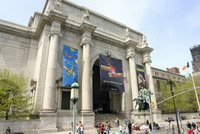New York's Museum of Natural History holds water exhibit
Water is everywhere. It falls slowly, drop by drop onto a surface below.

Elsewhere, a lever is lifted on a display model to demonstrate what happens when a dam is opened, water rushing forth to carry away and reshape the sediment below. A sculpture in another room displays water in all its states - solid, liquid and vapor - while a giant sphere representing the Earth shows where water is distributed around the world.
A new exhibit at the American Museum of Natural History is all about this most precious resource, its impact on the earth's environment, its impact on human beings, how it is used (wisely and not so wisely) and what can be done to ensure that supplies do not dangerously dwindle.
"Water: H2OLIFE" opens Saturday at the museum and runs through May 26. The museum organized the show in collaboration with institutions around the country and world, from Minnesota to California to Brazil to Australia to Singapore, and it will go on an extensive world tour after finishing its run in New York.
The purpose of the exhibit is to convey some key messages, said Eleanor Sterling, curator and director of the museum's Center for Biodiversity and Conservation.
Among those messages: that water is the basis of life on Earth; that it has been integral in shaping the geography of the planet and plays a major role in its climate; that our use of it affects others; that it is a limited resource. Even though the planet is covered with water, only 3 percent is freshwater and of that, most is locked away in glaciers or underground, leaving a tiny fraction for an increasing world population to use.
"We will never have any more than we have now," Sterling said, but consumption continues to rise. In some areas, conflicts over limited water resources have already happened, something that will only continue if people do not become better stewards.
"There's no question, water may increasingly be the resource that people are fighting over," she said.
And not just in other countries. Alabama, Florida and Georgia have been arguing over water rights for years, a clash that is only intensifying now amid a chronic Southern drought that is putting water supplies, agriculture and commercial fisheries at risk. Projections have at least 36 states facing water shortages within five years.
While the water-related troubles around the United States and the world are a "tragedy," Sterling said, they make the exhibit even more timely and hopefully will spur even more interest in the public.
"It gives it more of a sense of urgency," she said. "It may help to serve as a wake-up call to try to address these problems in a systematic way before they become too much more of a crisis."
Museum President Ellen Futter agreed, saying, "It's in all the headlines and I think people might really be ready to listen and that's very important."
The show was a couple of years in the planning, with part of it being a survey to determine what people knew about water (not much) and what they wanted to find out.
The exhibit has several different sections. One part shows how plant and animal life has adapted to differing levels of water availability, while another section takes visitors through a mock canyon to show how water can carve the face of our geography. Another section shows how civilizations have used water, from irrigation to dams, and an interactive screen tests viewers' knowledge of how much water goes into making products such as coffee or a T-shirt.
Parts of the exhibit show how people try to deal with living in areas that have an abundance of water, and those places that have a severe shortage, as well as some of the steps being taken to give people more access to water. The last section, which will change content based on where the exhibit is, shows ways people can become better water stewards in their daily lives.
"We want people to walk away with a sense of purpose and a sense of hope," Sterling said.
After New York, the show will be seen in Singapore; San Diego; St. Paul, Minnesota; Chicago; Cleveland; Canberra, Australia; and Toronto. Having so many international partners shows that the issue of water is one that should be of concern to people everywhere, not just one part of the globe, Futter said.
"Water is an issue that's beyond boundaries," she said. "We all have to work together on this."
Subscribe to Pravda.Ru Telegram channel, Facebook, RSS!


